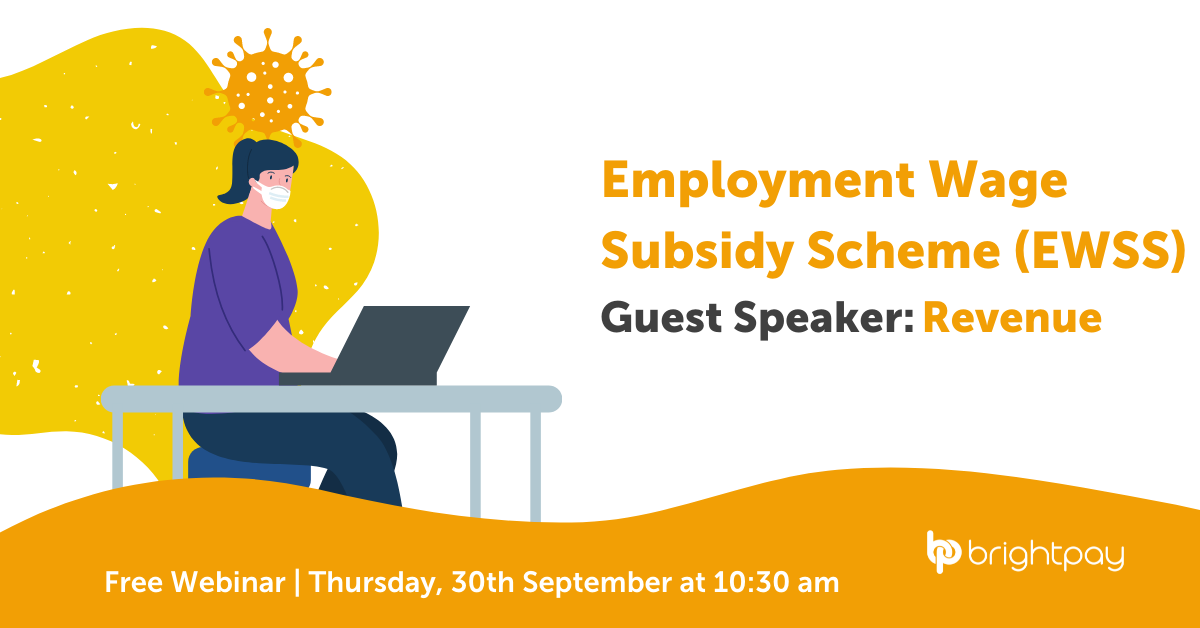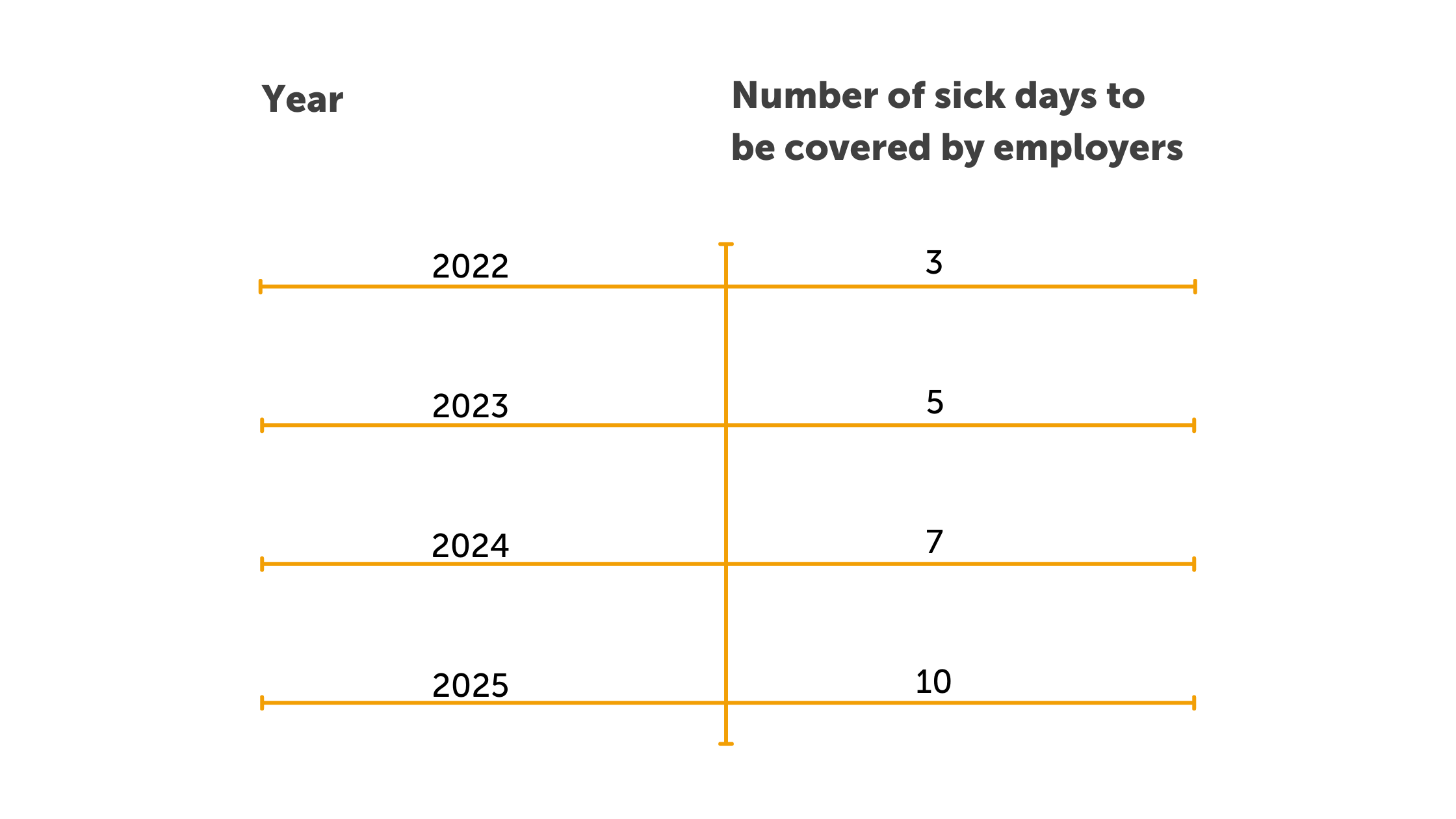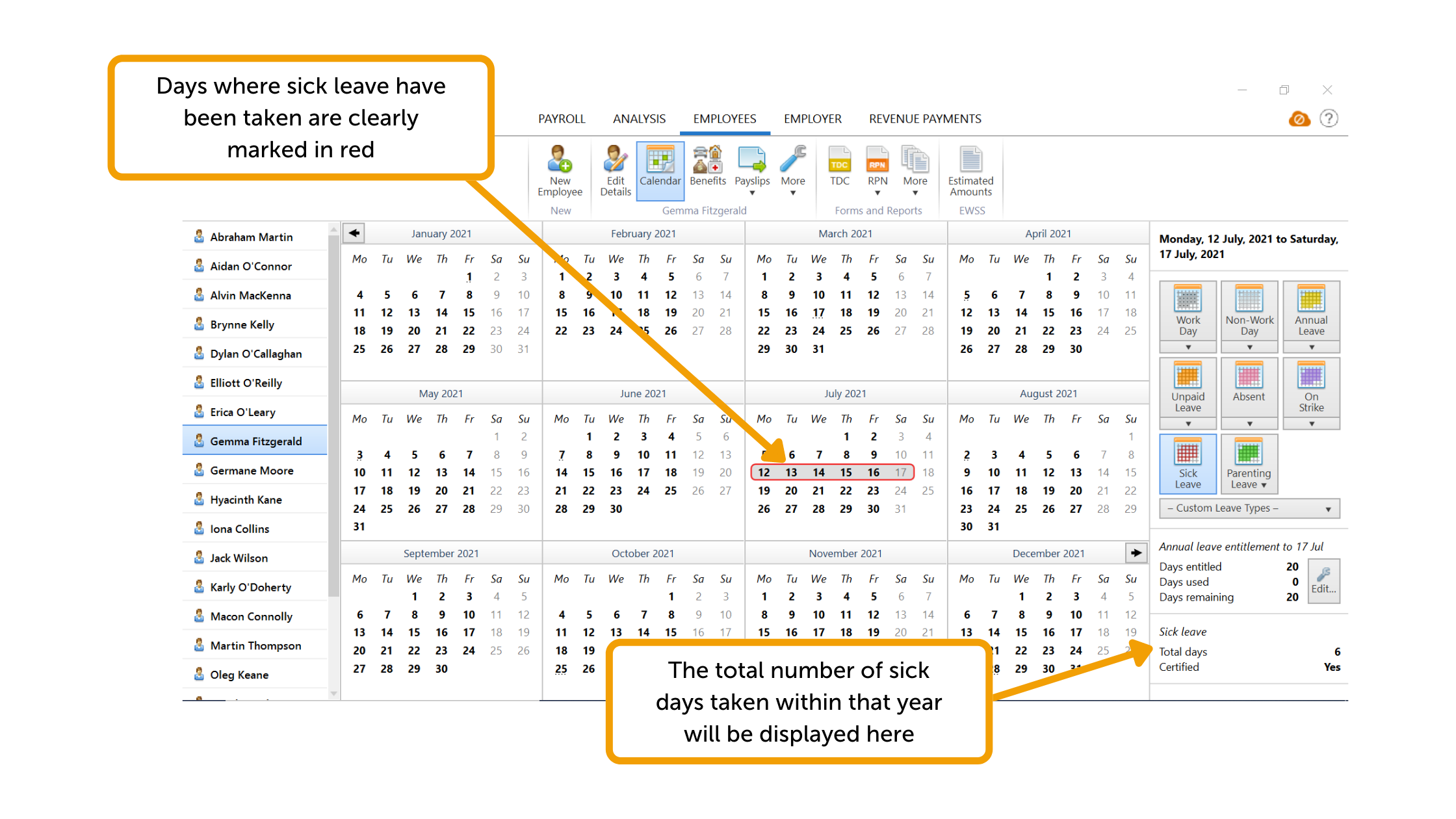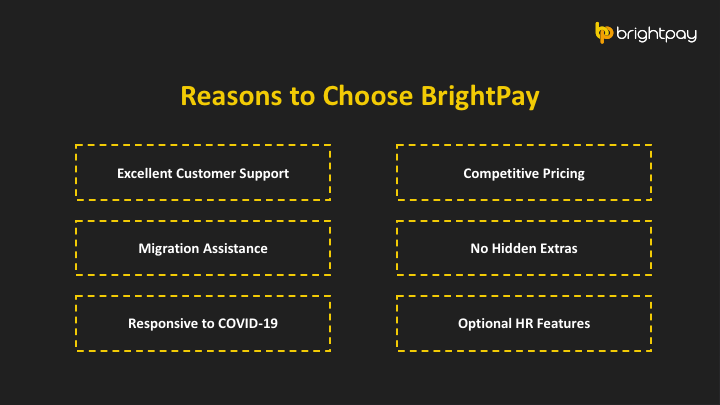Aug 2021
31
2021 Customer Survey - the results are in!
We value our customers’ feedback and opinions as it allows us to improve and grow our business. We recently conducted an annual survey as it is a powerful indicator of overall success as a company as it captures the entire experience of using BrightPay, from the product features to the daily customer support to the live webinars and online documentation.
We are proud of the continued high marks and appreciate the thoughtful feedback from this year’s survey and would like to say a massive thank you to everyone who took part. The survey looked at customer satisfaction, software performance and customer support.
We’ve compiled the results of our latest survey and we wanted to share them with you.
The Results
As the survey was very comprehensive, we’re not going to share the results of each and every question. But we did want to share the main areas of focus and what you, our customers, have said.
- We asked: How satisfied are you with BrightPay?
- You said: BrightPay achieved a 98.8% customer satisfaction rate, which is fantastic news for everyone on the BrightPay team.
- We asked: How would you rate the following BrightPay Connect features?
- You said: The most highly rated BrightPay Connect features included automatic cloud backup (98.8%), online employer dashboard (100%) and employee self-service portal & app (100%).
- We asked: How satisfied are you with BrightPay's Customer Support?
- You said: The majority of customers rated our telephone support (97.5%), email support (99.2%), online help documentation (97.1%) and online video tutorials (98%) as excellent, very good or good, giving our customer support team an overall satisfaction rate of 97.9%.
- We asked: How would you rate BrightPay’s handling of COVID-19?
- You said: 99.5% of customers answered that they found our handling of COVID-19 overall to be either excellent, very good or good - in particular, our free online COVID-19 webinars (99.6%), payroll upgrades (99.7%), online help and support (98.8%) and phone and email support (99.99%).
Customer Testimonials
We also received a number of customer testimonials from the survey - all of which will be added to the BrightPay website in due course. Some of our favourite testimonials received include:
“I found the functionality during my use of TWSS and EWSS outstanding”.
“A big thank you for your excellent TWSS / EWSS updates throughout the pandemic, they were very beneficial”.
“It is great to have an Irish company providing such a high level of service, support and innovation - the webinars are extremely useful”.
Get in touch
If you feel that you’re not using the full suite of BrightPay or BrightPay Connect’s features to its fullest potential, you can book a free 15-minute online BrightPay and/or BrightPay Connect demo.
Aug 2021
31
What happens if you don't submit Revenue’s Employer Eligibility Review Form?
The Irish government has extended the Employment Wage Subsidy Scheme (EWSS) until 31st December 2021. The scheme gives employers impacted by COVID-19, a subsidy per employee to help keep them in employment. On 9 July, Revenue published guidelines to highlight the changes to the EWSS applicable for the period from 1 July 2021. The main change made to the scheme was in relation to eligibility.
To assist employers in ensuring continued eligibility for the scheme, from 30th June 2021, all employers are required to complete and submit an online monthly EWSS Eligibility Review Form (ERF) through ROS by the 15th of each month. Companies claiming EWSS must fill out a monthly eligibility form, showing their revenue for 2021 remains at least 30% below the reference period in 2019 and a declaration to confirm that the information submitted is correct and accurate to the best of their knowledge. Failure to complete and submit the EWSS Eligibility Review Form that confirms the required reduction and related declaration will result in suspension of payment of EWSS claims.
Revenue has stated: “Where Revenue determines that an employer, at any time over the term of the scheme, claimed and received payment by applying accounting practices that are clearly not appropriate, or by deliberately misrepresenting the true financial situation of the business, it will be excluded from the EWSS in its entirety. No further claims will be accepted, and all subsidy paid and PRSI credit issued will be immediately repayable together with interest and penalties. The business may also face possible criminal prosecution.”
The government has paid nearly €4 billion to date in EWSS payments on top of the €2.9 billion paid under the earlier TWSS. Revenue have launched an investigation on companies that are suspected of overclaiming pandemic wage subsidies.
According to Revenue’s code of practice for audits and non-audit interventions, officials can make unannounced site visits, conduct profile interviews with business owners, carry out assurance checks, and initiate investigations. Please ensure you are submitting correct information to avoid any penalties.
Upcoming webinar
Join BrightPay for a free webinar on 30th September where we will be joined by representatives from the Revenue Commissioners to discuss upcoming changes to the Employment Wage Subsidy Scheme in October and the Employer Eligibility Review Forms. There will also be a live Q&A session to answer any questions that you may have.
Limited Places Remaining – Click here to reserve your place.

Related articles:
Aug 2021
19
Sick pay comes to Ireland: How does this affect employers and payroll processors?
In Ireland, employers currently do not have any legal obligation to pay employees who are absent from work due to illness. In the private sector, it is at the discretion of the employer as to whether or not they decide to pay employees who are unable to work due to sickness.
A survey from 2019 found that only 44% of employers offered their employees some form of paid sick leave. For employees working in the public sector, The Public Sector Sick Leave Scheme was introduced in 2014. Under the scheme, public sector employees are entitled to 7 days paid sick leave within a continuous 2-year period, without having to submit a medical certificate. When a medical certificate is provided, employees are entitled to 92 calendar days of fully paid sick leave followed by 91 calendar days on half pay, subject to a maximum of 183 calendar days in a rolling 4-year period.
The effects of the COVID-19 pandemic shone a light on the need for statutory sick pay to be introduced into the private sector. Having no sick pay entitlements meant that employees were more likely to attend work, despite experiencing symptoms of COVID-19, risking passing on the virus to colleagues. Employees who were working from home also took fewer sick days during the pandemic as because they did not have to leave their homes they continued to work, despite feeling unwell. Both of these situations can be damaging to an employee’s health.
How does offering sick pay benefit employers?
When there is no sick pay scheme in place, many employees will attend work while unwell as they do not want to miss out on pay. This does not benefit either the employer or the employee. If the employee is trying to work while they are sick, they are not going to be able to be as productive as they usually would be. This could also lengthen the time it takes for them to recover from the illness and they may not be able to work to their full potential for a lot longer than it would have been if they had taken the time off needed to recuperate.
Offering employees sick pay leave can actually help reduce the number of sick days taken by employees overall. As well as getting better faster, If the employee does not come into the workplace sick, they won't spread the sickness to other employees.
What sick pay is being introduced?
Statutory entitlement to sick pay will be phased in as part of a 4-year plan beginning in January 2022 and will be paid by employers at a rate of 70% of an employee’s wage, subject to a daily threshold of €110. The table below shows how the number of sick days covered by employers will rise over the four years.
How does the introduction of statutory sick pay affect payroll?
Payroll processors may be wondering how the introduction of statutory sick pay in Ireland will affect how they calculate pay for employees who have taken sick leave. Within BrightPay payroll software, at the moment, if an employer offers paid sick leave to their employees, payroll processors can add sick pay as an ‘addition type’ within the payroll software. The employer can then manually add the amount of sick pay owed to the employee when entering the employee’s pay information for that period. The employer can add sick days taken to the employee’s calendar and choose whether these days were certified or uncertified. The days where sick leave have been taken will be colour-coded and the total number of sick days taken will be displayed on the bottom right-hand side of the screen. This means that you can clearly track the number of sick days taken by each employee.
Through our optional cloud add-on, BrightPay Connect, employees can access an online portal through an internet browser or through the BrightPay Connect mobile app. Any days taken as sick leave will be highlighted meaning that the employee can keep track of how many sick days they have taken so far that year.

At BrightPay, through the UK version of our software, we have experience with applying sick leave entitlements to employee’s pay since 2012. Having this experience means we are well prepared to make any changes to the Irish version of our software that will make calculating and tracking an employee’s Statutory Sick Pay entitlements as easy as possible for payroll processors.
To learn more about BrightPay’s features, book a free online demo today.
Related articles:
Aug 2021
12
7 reasons why you should process payroll in-house
When we weigh up the pros and cons of outsourcing versus in-house payroll, you can see there are many benefits that your business can gain by making the switch to bringing payroll in-house. Internal staff resources can be reassigned to payroll processing to help mitigate the monetary impact of the pandemic on your business's outgoings.
Processing payroll in-house can offer financial rewards and provide several added benefits including:
- Reduced business overheads and potential cost savings
- Increased control over payroll reporting
- Internal flexibility over payroll scheduling and last-minute changes
- Minimal reduction in workload
- Streamlined HR and annual leave processes
- Self-service online access for employees
- Increased accurate reporting through API integration with accounting and bookkeeping software
Although there are some benefits to outsourcing your payroll, you can get the best of both scenarios when you choose the right payroll software.
Having the right provider for your business is crucial and can mean the difference between a laborious payroll process that you dread every pay period, and a quick and easy payroll that you hardly think about at all. But finding the right one isn’t necessarily as easy as it seems. There are so many payroll software providers today that sifting through them can be overwhelming. To make it easier for you, we have summarised the key reasons why you should use BrightPay.

Is BrightPay the right in-house payroll software for your business? If you’re thinking about bringing payroll in-house, now could be the right time to make that transition. Get in touch and book a free 15-minute online demo.
Related articles:
Aug 2021
3
BrightPay Customer Update: August 2021
Welcome to BrightPay's August update. Our most important news this month include:
-
Watch On-Demand: EWSS Changes & The Return to Work
-
Going paperless: how an employee app can help
-
How Statutory Sick Pay will be calculated when introduced in 2022
EWSS Employer Eligibility Review Form
Revenue confirmed it has extended the deadline for the completion and submission of the EWSS Eligibility Review Form in respect of June 2021 to 15 August 2021. The eligibility review form in respect of July 2021 is also due to be submitted on the same date. Watch our webinar on-demand where we cover everything you need to know.
BrightPay’s new payroll journal integration with accounting software
We are delighted to announce BrightPay’s new API integration with AccountsIQ, Quickbooks Online, Sage Business Cloud Accounting and Xero. BrightPay users will be able to create wages journals from the finalised payslips and send the payroll data directly into their accounting software.
Statutory Sick Pay - Coming January 2022
Currently, there is no legal obligation for employers in Ireland to pay employees who are on sick leave, and it is up to the discretion of each employer. However, it will be mandatory for employers in Ireland to provide Statutory Sick Pay (SSP) for employees from January 2022.
Employee self-service app – A must-have tool for every business
BrightPay Connect gives employees access to a user-friendly smartphone and tablet app that gives them access to their payslips, HR documents, annual leave calendar and much more. Self-service apps are becoming more popular as they benefit both the employer and employee.
Adopting a hybrid working model
The COVID-19 crisis has completely shifted the way we work and live with companies having to quickly adopt new initiatives and technologies to ensure employee safety whilst maintaining productivity. Join Bright Contracts for a free online webinar on the 25 August where our team of experts will discuss how hybrid working has changed the way we work and live and what this change means for your business.







